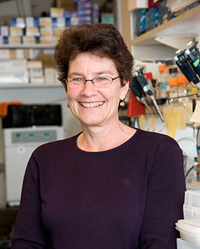Researchers at the University of Utah’s Mansour Lab are studying the Fibroblast Growth Factor signaling pathway with the long-term goal of harnessing developmental signals to drive hearing restoration.
“Our results will contribute new knowledge to the long-term goal of harnessing developmental signals to drive hearing restoration.”
The project has received funding from the National Institute on Deafness and Other Communication Disorders (NIDCD) and will continue through January 2022.
According to investigators, the results “will facilitate future efforts to manipulate the FGF signaling system for hearing restoration.”
First, they will use mouse models to investigate the role of the Fibroblast Growth Factor signaling pathway and its critical role in the inner ear.
But the findings could uncover key development signals that could potentially be commandeered to restore hearing function.

The team is being led by Dr. Suzanne L. Mansour (Molecular Biology Program – FGFs and Inner Ear Development, Mouse models of hearing loss and restoration), who has been studying these FGF signals since the early 2000s.
Here is the full abstract and public health relevance statement:
Regulation of inner ear development by FGF signals and effectors
Mansour, Suzanne L.
University of Utah, Salt Lake City, UT, United StatesAbstract
Morphogenesis of the inner ear epithelium requires coordinated deployment of several signaling pathways and disruptions cause abnormalities of hearing and/or balance. With the advent of cochlear implantation to treat hearing loss even in cases of inner ear malformation, it is critical to understand exactly how such malformations affect the auditory ganglia and innervation. Also, in light of the intense focus on in vitro generation of inner ear cell types for transplantation and in vivo manipulation of developmental signaling molecules to promote differentiation of various inner ear cells for hearing restoration, elucidating the roles and regulation of such signals and their effectors governing otic differentiation and morphogenesis are necessary to advance treatment. The genes encoding FGF3 and FGF10, ligands that signal through FGFR2b and FGFR1b, are expressed dynamically throughout otic development in both epithelial and ganglion domains. Studies conducted by the Mansour Lab of both conventional Fgf3 and Fgf10 conditional knockout mice and those expressing a doxycycline-inducible ligand trap (dnFGFR2b) that rapidly inhibits signaling through both FGFR1b and FGFR2b, showed that Fgf3 and Fgf10 are not required in the placode lineage for otocyst formation, but are required subsequently for otocyst patterning, neuroblast maintenance, epithelial proliferation and both vestibular and cochlear morphogenesis. Furthermore, the first genome wide analyses of otocyst mRNA revealed FGFR2b/1b signaling targets that define novel candidates for genes involved in otic morphogenesis and function. This proposal has two Aims addressing the hypotheses that 1) FGFR2b/1b signaling is required continuously for both otic neuroblast specification and maintenance, and that at later stages, mesenchymal signaling, as well as that in the epithelial and ganglion domains, is required for cochlear epithelial differentiation and ganglion maintenance and 2) FGFR2b/1b downstream target genes mediate some or all of the effects of FGFR2b/1b signaling on otic morphogenesis and gangliogenesis. To determine the early role of FGFR2b/1b signaling in otic ganglion formation and its later role in epithelial differentiation and ganglion maintenance, DOX-induced ubiquitous and CRE-limited expression of dnFGFR2b will be employed and morphology and molecular markers of otic patterning, proliferation and survival in both tissues will be assessed. To determine the roles of downstream targets of FGFR2b/1b signaling, two genes encoding transcription factors that are activated by FGFR2b/1b signaling and one gene encoding a BMP signaling regulator that is repressed by FGFR2b/1b signaling will be studied. Otic conditional mutants will be generated for each gene, and their morphologic and functional development will be assessed. In addition, the extent to which the BMP regulator contributes to the dnFGFR2b phenotypes and the effects of overexpressing the BMP regulator will be assessed. The results will contribute new knowledge that will facilitate future efforts to manipulate the FGF signaling system for hearing restoration.
Public Health Relevance
Permanent hearing loss caused by malformation of the inner ear or congenital or progressive loss of its sensory or neural cells affects up to one third of individuals by the age of 80 and generates significant social and healthcare costs. In this proposal, we use mouse models to investigate the role of the Fibroblast Growth Factor signaling pathway in forming the inner ear epithelium and neurons. Our results will contribute new knowledge to the long-term goal of harnessing developmental signals to drive hearing restoration.
For updates on Mansour’s FGF signaling system (and other hearing restoration research/treatments) sign up for free email updates (our newsletter) here.
References
Project #: 1R01DC019127-01